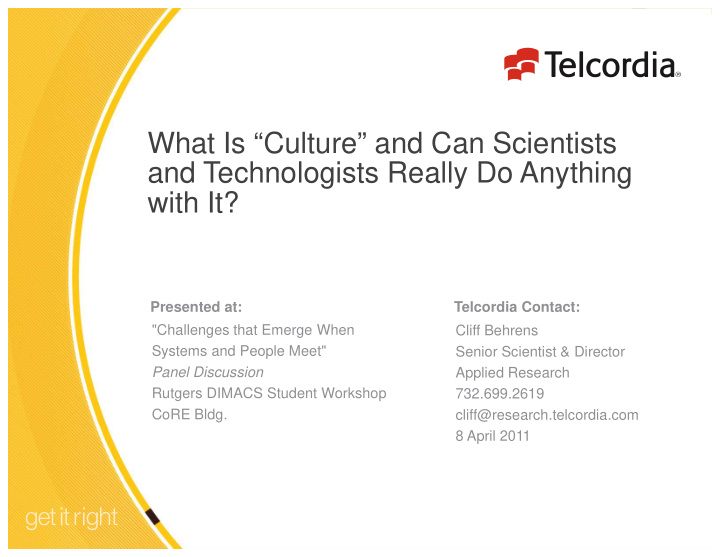



What Is “Culture” and Can Scientists and Technologists Really Do Anything with It? Presented at: Telcordia Contact: "Challenges that Emerge When Cliff Behrens Systems and People Meet" Senior Scientist & Director Panel Discussion Applied Research Rutgers DIMACS Student Workshop 732.699.2619 CoRE Bldg. cliff@research.telcordia.com 8 April 2011 1
Culture: What is it and how can we use it? ■ Kroeber and Kluckholm (1952) listed more than 200 definitions of “culture” 1 ■ length of this list has only increased since then ■ still much contention among anthropologists ■ no right or wrong definition…only what best suits problem at hand, i.e., operational definition ■ Theory of the world shared in its broad design and deeper principles by members of a society principles by members of a society ■ what one needs to know in order to behave like a “native” ■ entire details are not usually known (or can always be articulated explicitly) by anyone ■ consists of those things that all members understand all others hold to be true ■ Highly-structured, rich form of knowledge ■ coherent conceptual system (embedded logic) that tends to persist as a unit, i.e., is passed-on and learned 1 Kroeber, A.L. & Kluckhohn, Clyde (1952) "Culture: A Critical Review of Concepts and Definitions." Papers of the Peabody Museum of Harvard Achæology and Ethnology, Harvard University 42(1). Cambridge, Mass: Museum Press. 2
Framework and Key Concepts Culture: Shared Knowledge ���������� ���������� ⇒ ���������� ⇒ ���������� ⇒ ��������� ⇒ ��������� ��������� ��������� ⇒ ⇒ ⇒ ⇒ ⇒ ⇒ ⇒ ⇒ ⇒ ⇒ ⇒ ⇒ Cognition: Cognition: Individual Knowledge Behavior: Information Sharing among Individuals in a Society 3
Applications for Culture in CS and Systems Design ■ User Interface Design ■ Icons, labels, layout, use of windows, e.g., what does mean? ■ Query languages and search, e.g., highly-contextualized semantics - See a “fish,” eat “fish,” or “fish” for information. - Veo un “pez,” pero como “pescado”, y ???? ■ System Architecture ■ Representations such as data models, ontologies, schemas ■ Representations such as data models, ontologies, schemas ■ Network designs for facilitating collaboration and knowledge-building in the forms of information exchange and recommendation, e.g., Amazon, ebay, Facebook, and Wikipedia. ■ Modeling Human Behavior and Cognition ■ Agent-based modeling of social-cognition in multicultural society - Role of shared representations in learning and situational awareness ■ Embedding of knowledge in behavioral artifacts, e.g., books, databases, machines 4
Recommend
More recommend